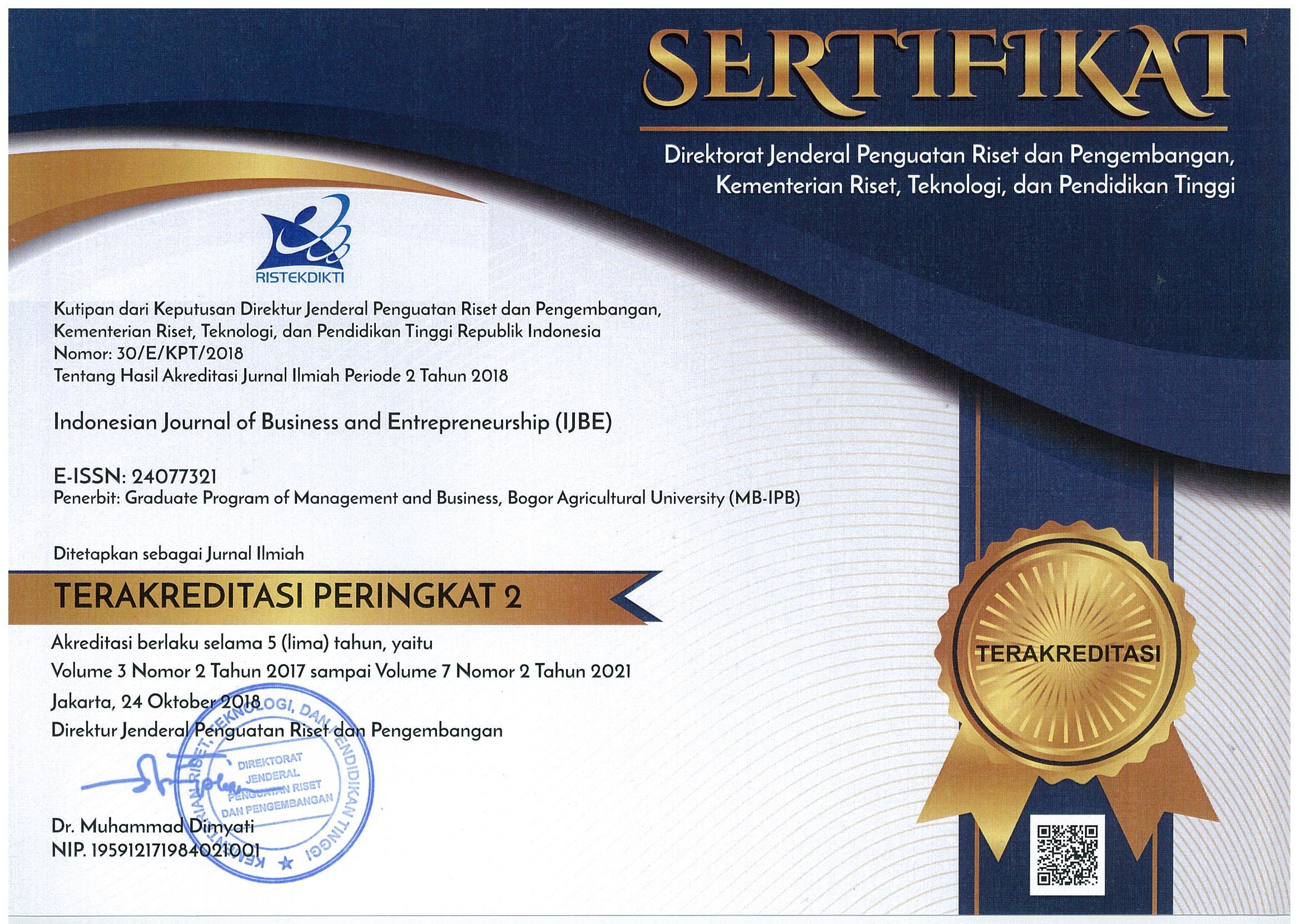Business Model Canvas and Strategies to Develop Biodiesel Industry of PT. XYZ in Order to Implement CPO Supporting Fund Policy
Abstract
Biodiesel is considered as one of the alternative eco-friendly fuels. Besides, the government also issued policy related to biodiesel that is CPO Supporting Fund (CSF) Policy. The aim of the research is to identify Business model canvas (BMC) biodiesel industry in PT XYZ and to know the strategies to develop business from biodiesel industry in line with the CPO supporting fund policy. The analysis tool used in this research is BMC, SWOT and Quantitative Strategic Planning Matrix (QSPM). The research results in identifying BMC of PT XYZ is customer segment that the company serves in the form of domestic as well international customers. The value the company offers is biodiesel quality that is in accordance with SNI standard and the distribution is at the company’s cost; the relationship built with the customers is by communities and co-creation; the marketing network through stock exchanges and commodity exchanges; the revenue obtained from selling biodiesel and the price difference between biodiesel and solar from BPDPKS; the company’s resources are human resource, raw material resource, and financial resource; the main activities carried out by the company is CPO process to become biodiesel and sale; the company’s partners are GAPKI, BPDPKS and APROBI; the cost structure is operational cost, workers’ salary, and CPO levy fund. Furthermore, the strategy to develop biodiesel industry in line with the rapid increase of competitiveness is to increase the biodiesel production capacity and communication improvement and CRM to improve customers’ service.
Keywords: biodiesel, CPO supporting fund (CSF), levy fund, vegetable oil (BBN), business model canvas (BMC)
Downloads
References
Bustaman S. 2009. Strategi pengembangan industri biodiesel berbasis kelapa di Maluku. Jurnal Litbang Pertanian 28(2): 46–53.
Boedianto LP, Harjanti D. 2015. Strategi pengembangan bisnis pada depot selaras dengan pendekatan businmess canvas model. Jurnal Agora 3(2): 292–301.
Boedianto LP, Harjanti D. 2015. Strategi pengembangan bisnis pada depot selaras dengan pendekatan businmess canvas model. Jurnal Agora 3(2):292–301.
Dyantina O, Afrina M, Ibrohim A. 2012. Penerapan Customer Relationship Management (CRM) berbasis web (studi kasus pada sistem informasi penukaran di toko Yen-Yen). Jurnal Sistem Informasi 4(2): 516–529.
Harisudin M. 2013. Pemetaaan dan strategi pengembangan agroindustri tempe di Kabupaten Bojonegoro Jawa Timur. Jurnal Teknologi Industri Pertanian 23(2): 120–128.
Hudori M. 2014. Review bisnis model dan daya saing industri agribisnis. Malikussaleh Industrial Engineering Journal 4(1): 56–61.
[ESDM] Kementerian Energi Sumber Daya Mineral Republik Indonesia. 2015. Outlook Energi Indonesia. Jakarta: ESDM.
[Kemendag] Kementerian Perdagangan Republik Indonesia. 2013. Analisis Peningkatan Penggunaan Biodiesel Sebagai Upaya Mengatasi Defisit Neraca Perdagangan Migas. Jakarta: Kemendag.
Masykur. 2013. Pengembangan industri kelapa sawit sebagai penghasil energi bahan bakar alternatif dan mengurangi pemanasan global. Jurnal Reformasi 3(2): 96–107.
Maulana A, Aziz M. 2012. Kinerja dan prospek pengembangan bahan bakar nabati di Indonesia. Jurnal Agro Ekonomi 30(2): 147–158.
Murtiningrum FA. 2016. Perkembangan biodiesel di Indonesia tinjauan atas kondisi saat ini, teknologi produksi & analisis prespektif. Jurnal PASTI 9(1): 35–45.
Nurmanisa A, Wilopo, Sanawiri B. 2016. Analisis customer segment, channel dan customer relationship dalam pembentukan value proposition di Starbucks Coffe. Jurnal Administrasi Bisnis 34(1): 10–18.
Pahan I. 2008. Panduan Lengkap Kelapa Sawit Manajemen Agribisnis dari Hulu Hingga Hilir. Jakarta: Penebar Swadaya.
Rachmaniah O, Baidawi A, Latif I. 2009. Produksi biodiesel berkemurnian tinggi dari Crude Palm Oil (CPO) dengan tertrahidrofuron-fast single-phase process. Jurnal Reaktor 12(3): 166–174.
Rahayu M. 2007. Teknologi Proses Produksi Biodiesel. Jakarta: Badan Penelitian dan Pengembangan Teknologi.
Rangkuti F. 2013. Teknik Membedah Kasus Bisnis: Analisis SWOT, Cara Perhitungan Bobot, Rating dan OCAI. Jakarta: PT Gramedia Pustaka Utama.
Sembiring MT. 2015. Model biaya produksi biodiesel berbasis minyak sawit. Jurnal Litbang Industri 5(1): 23–36. https://doi.org/10.24960/jli.v5i1.663.23-36.
Setijawibawa M. 2015. Evaluasi model bisnis pada perusahaan x menggunakan business model canvas. Jurnal AGORA 3(1): 305–313.
Sugiyono. 2009. Metode Penelitian Kuantitatif dan Kualitatif. Bandung: Remaja Rosdakarya.
Tety E, Hutabrat A, Putra F. 2012. Prospek komoditas minyak kelapa sawit (CPO) dalam pengembangan biodiesel sebagai alternatif bahan bakar di Indonesia. Jurnal Pebkis 4(3): 152–162.
Wiharjanto. 2013. Analisis strategi pengembangan industri hilir kelapa sawit pada PT SMART Tbk [tesis]. Yogyakarta: Universitas Gadjah Mada.
Wiska F, Syarief R, Baga LM. 2016. Mengambangkan sekolah peternakan rakyat menggunakan pendekatan bisnis model canvar case study: Kota Bojonegoro. Indonesia Journal of Business and Entrepreneruship 2(2) : 69–81. https://doi.org/10.17358/IJBE.2.2.69.
Wijaya H. 2015. Perumusan kebijakan biodiesel kelapa sawit dengan menggunakan metode regulatory impact analysis dan model sistem dinamis [tesis]. Bogor: Institut Pertanian Bogor.








